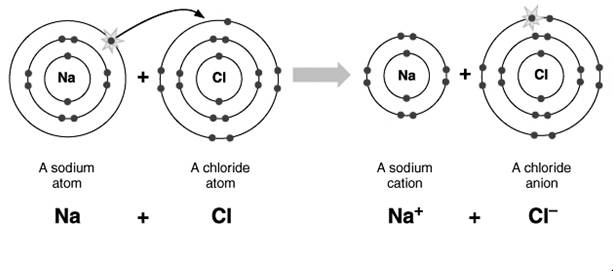
Concept explainers
The __________is that part of an atom that moves from one atom to another.
A. electron
B. proton
C. neutron
The part of an atom that moves from one atom to another.
Answer to Problem 1RQ
The correct answer is (a) electron.
Explanation of Solution
An atom is the smallest part of a substance that is made up of electron, neutron and protons. The neutrons as the name suggest has no charge, while the protons are positively charged ions and the electrons are negatively chargedions present in the outermost shell moves around the nucleus of an atom. When a sufficient amount of energy or force is applied to an atom, the outer electron become free and can move from one atom to another.
In the given figure, an atom of sodium having excess of electron and another atom of chlorine having a deficiency of electron thus, both the atoms become stable by transferring an electron from sodium atom to chlorine and forming a covalent bond between them.
Thus, the electron is the smallest ion that moves from one atom to another.

Proton:
The proton being heavier in mass as compared to electron cannot be able to move from one atom to another.
Neutron:
They are found in the nucleus of an atom.
The protons and neutrons stick together in the nucleus of an atom during normal conditions.
Want to see more full solutions like this?
Chapter 12 Solutions
Refrigeration and Air Conditioning Technology (MindTap Course List)
- BONUS: If the volume of the 8cm x 6.5cm x 6cm Block of Aluminum was 312cm3 before machining, find how much material was removed when the fixture below was machined. +2 2.00 cm 6.00 cm 2.50 cm 6.50 cm 1.00 cm 2.50 cm 11.00 cm 8.00 cm 30 CP 9411 FL.4) (m² 1157 Area of triangle = 1/2*B*H Area of circle = лR² Circumference of a circle = 2πR 6.00 cm 6.50 cm 1.50 cm Radius 1.50 cm 1.00 cmarrow_forwardConsider a 5m by 5m wet concret patio with an average water film thickness of .2mm. Now wind at 50 km/h is blowing over the surface. If the air is at 1 atm, 15oC and 35 percent relative humidity, determine how long it will take for the patio to completely dry.arrow_forward70. Compute the number of cubic centimeters of iron required for the cast-iron plate shown. The plate is 3.50 centimeters thick. Round the answer to the nearest cubic centimeter. 50.0 cm 40.0 cm Radius 150° 115.0 cm- 81.0 cmarrow_forward
- Law of Sines Solve the following problems using the Law of Sin 7. Find side x. All dimensions are in inches. -°-67°-37° 81° x Sin A 8.820 X 67°00' 32°00' a sin A b C sin B sin Carrow_forward35. a. Determine B. b. Determine side b. c. Determine side c. 5.330 in.- ZB 73°30'arrow_forwardConsider a 12 cm internal diameter, 14 m long circular duct whose interior surface is wet. The duct is to be dried by forcing dry air at 1 atm and 15 degrees C throught it at an average velocity of 3m/s. The duct passes through a chilled roo, and it remains at an average temp of 15 degrees C at all time. Determine the mass transfer coeeficient in the duct.arrow_forward
 Refrigeration and Air Conditioning Technology (Mi...Mechanical EngineeringISBN:9781305578296Author:John Tomczyk, Eugene Silberstein, Bill Whitman, Bill JohnsonPublisher:Cengage Learning
Refrigeration and Air Conditioning Technology (Mi...Mechanical EngineeringISBN:9781305578296Author:John Tomczyk, Eugene Silberstein, Bill Whitman, Bill JohnsonPublisher:Cengage Learning Automotive Technology: A Systems Approach (MindTa...Mechanical EngineeringISBN:9781133612315Author:Jack Erjavec, Rob ThompsonPublisher:Cengage Learning
Automotive Technology: A Systems Approach (MindTa...Mechanical EngineeringISBN:9781133612315Author:Jack Erjavec, Rob ThompsonPublisher:Cengage Learning

